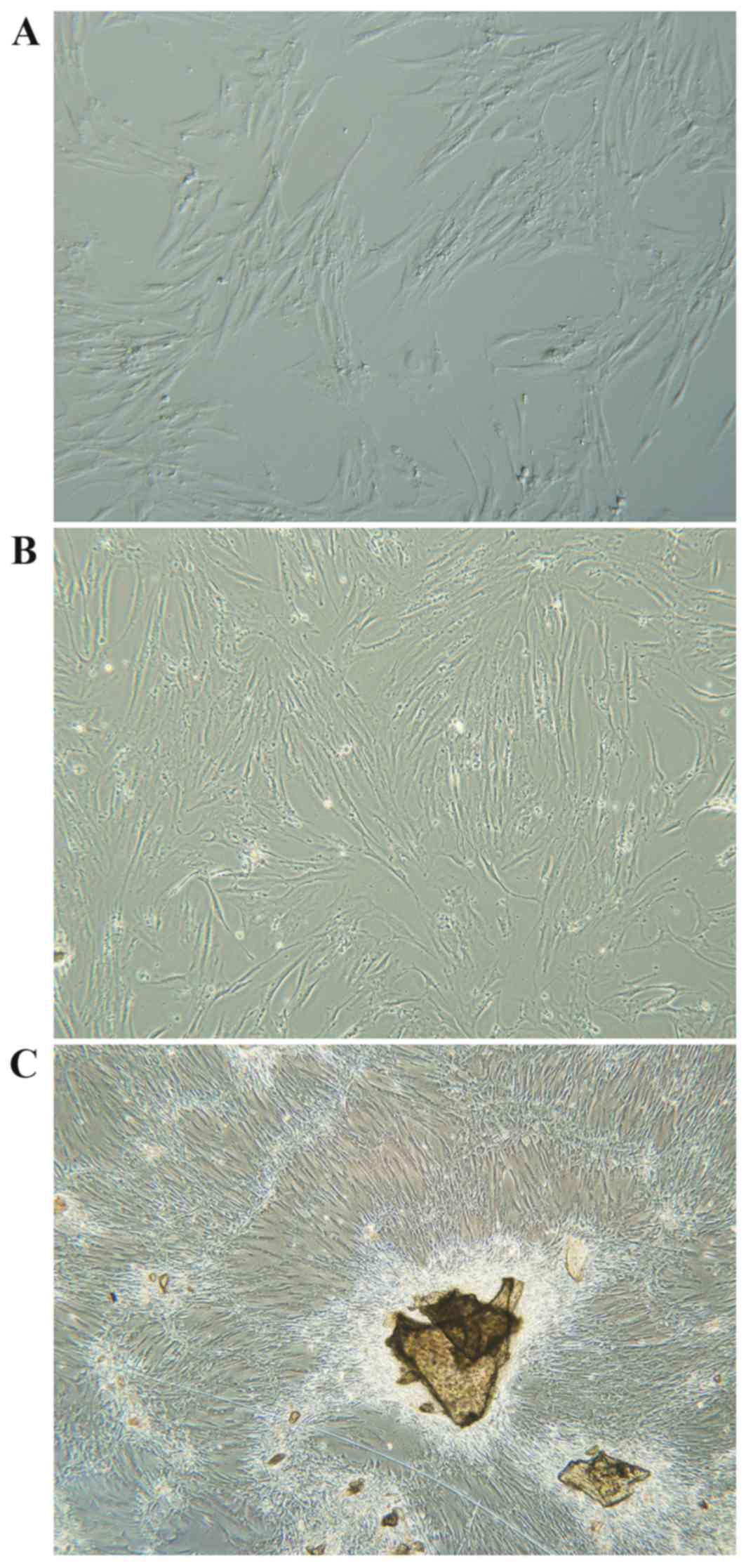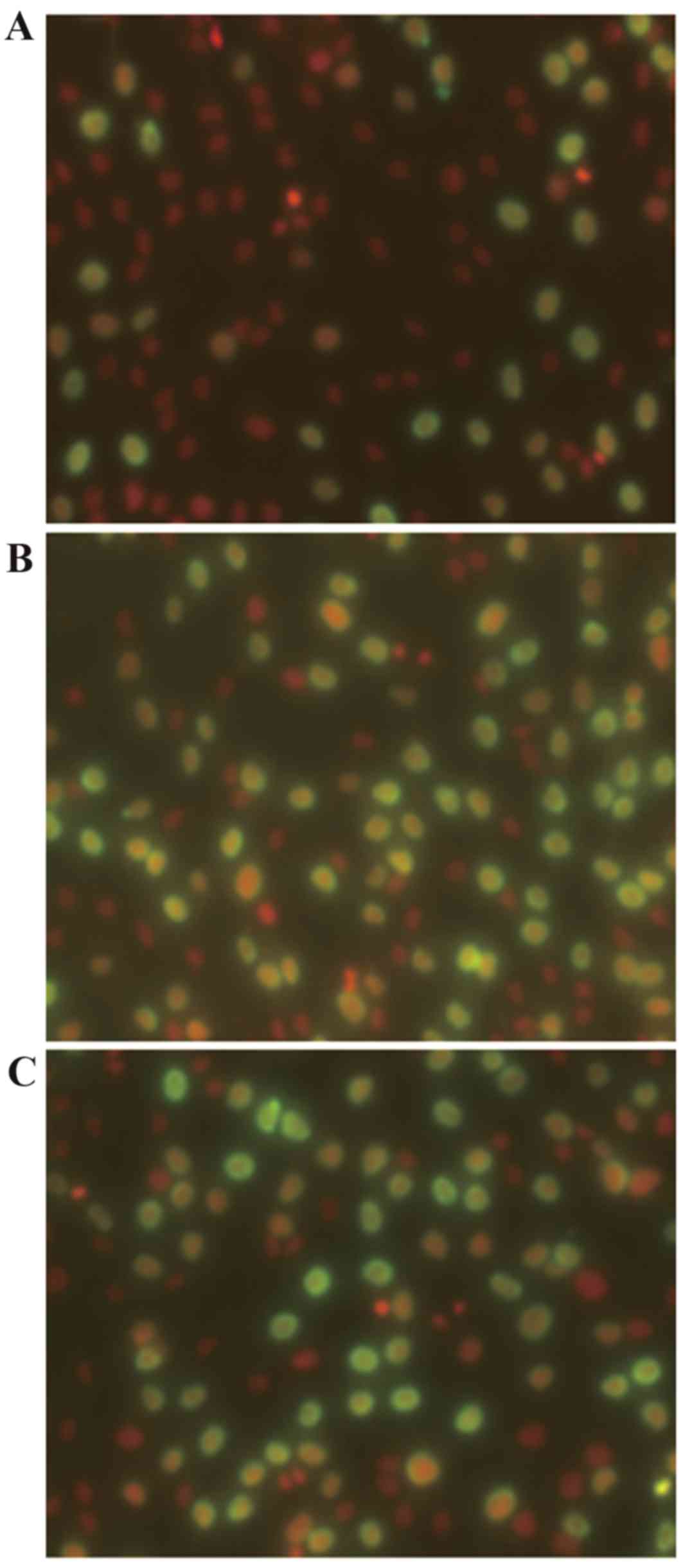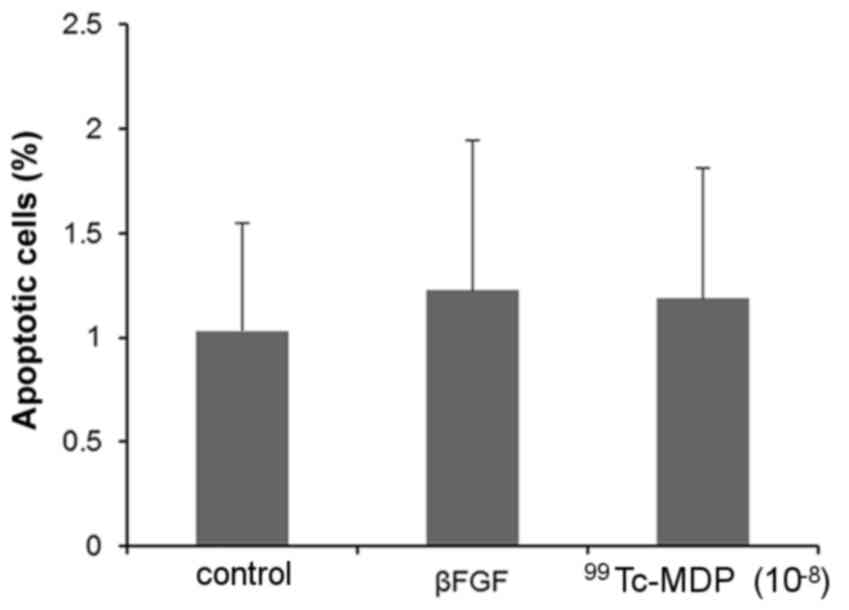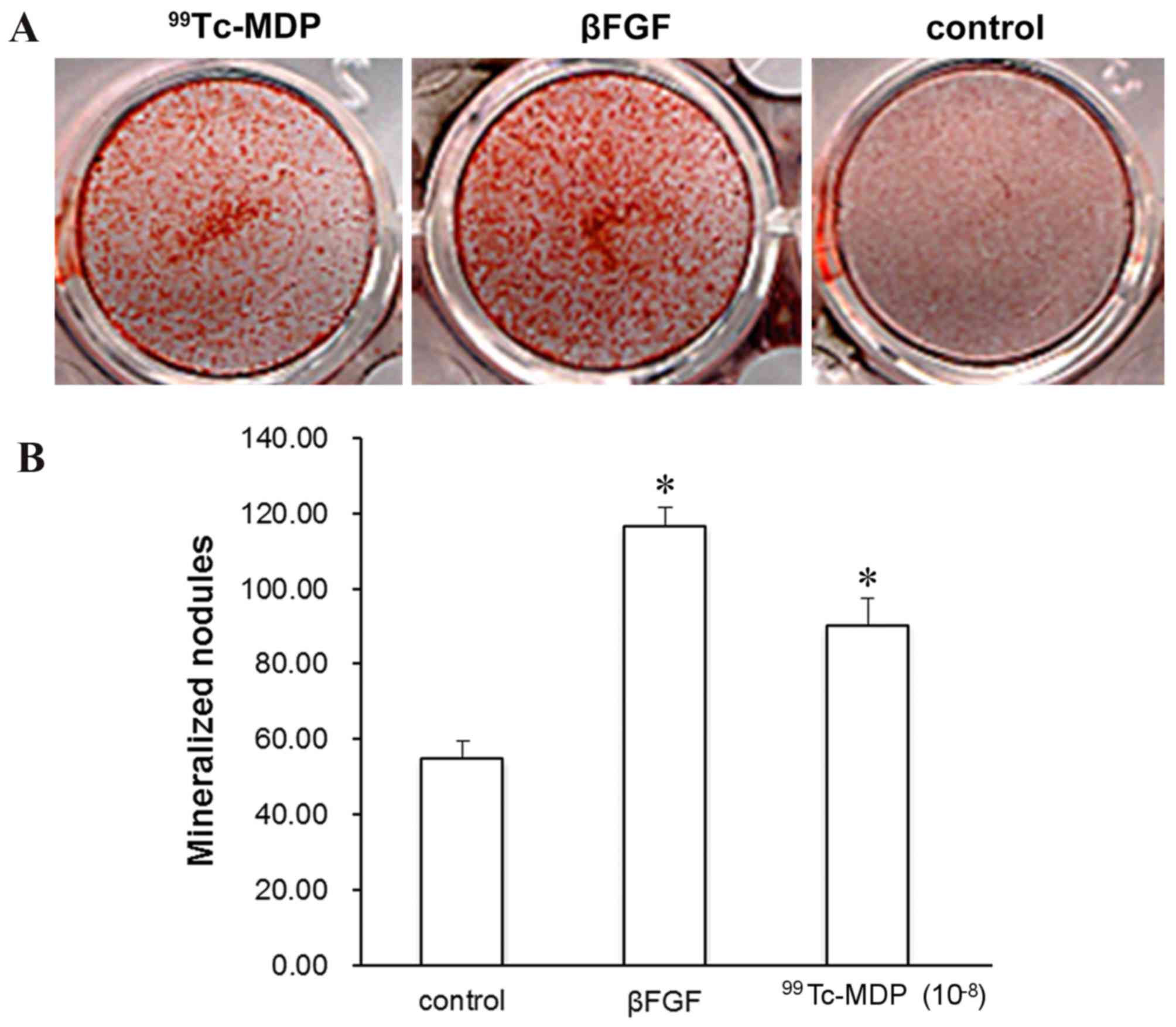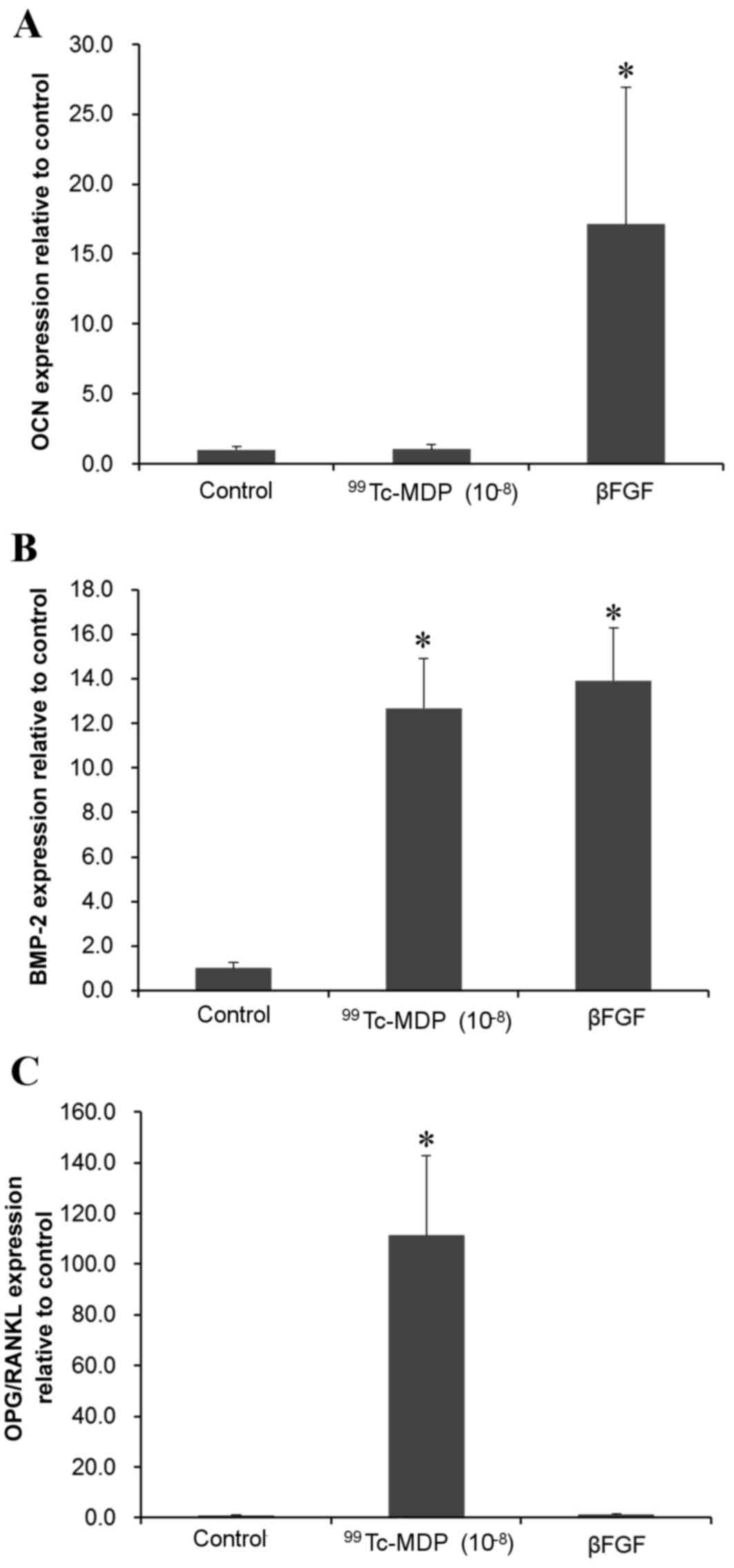|
1
|
Thommesen L, Stunes AK, Monjo M, Grøsvik
K, Tamburstuen MV, Kjøbli E, Lyngstadaas SP, Reseland JE and
Syversen U: Expression and regulation of resistin in osteoblasts
and osteoclasts indicate a role in bone metabolism. J Cell Biochem.
99:824–834. 2006. View Article : Google Scholar : PubMed/NCBI
|
|
2
|
Stein GS and Lian JB: Molecular mechanisms
mediating proliferation/differentiation interrelationships during
progressive development of the osteoblast phenotype. Endocr Rev.
14:424–442. 1993. View Article : Google Scholar : PubMed/NCBI
|
|
3
|
Pockwinse SM, Stein JL, Lian JB and Stein
GS: Developmental stage-specific cellular responses to vitamin D
and glucocorticoids during differentiation of the osteoblast
phenotype: Interrelationship of morphology and gene expression by
in situ hybridization. Exp Cell Res. 216:244–260. 1995. View Article : Google Scholar : PubMed/NCBI
|
|
4
|
Quarto N, Li S, Renda A and Longaker MT:
Exogenous activation of BMP-2 signaling overcomes TGFβ-mediated
inhibition of osteogenesis in Marfan embryonic stem cells and
Marfan patient-specific induced pluripotent stem cells. Stem Cells.
30:2709–2719. 2012. View Article : Google Scholar : PubMed/NCBI
|
|
5
|
Teitelbaum SL: Bone resorption by
osteoclasts. Science. 289:1504–1508. 2000. View Article : Google Scholar : PubMed/NCBI
|
|
6
|
Takahashi N, Udagawa N and Suda T: A new
member of tumor necrosis factor ligand family,
ODF/OPGL/TRANCE/RANKL, regulates osteoclast differentiation and
function. Biochem Biophys Res Commun. 256:449–455. 1999. View Article : Google Scholar : PubMed/NCBI
|
|
7
|
Hofbauer LC and Heufelder AE: Role of
receptor activator of nuclear factor-kappaB ligand and
osteoprotegerin in bone cell biology. J Mol Med (Berl). 79:243–253.
2001. View Article : Google Scholar : PubMed/NCBI
|
|
8
|
Khosla S: Minireview: The OPG/RANKL/RANK
system. Endocrinology. 142:5050–5055. 2001. View Article : Google Scholar : PubMed/NCBI
|
|
9
|
Lai K, Jin C, Tu S, Xiong Y, Huang R and
Ge J: Intravitreal injection of (99)Tc-MDP inhibits the development
of laser-induced choroidal neovascularization in rhesus monkeys.
Graefes Arch Clin Exp Ophthalmol. 252:1049–1057. 2014. View Article : Google Scholar : PubMed/NCBI
|
|
10
|
Lai K, Xu L, Jin C, Wu K, Tian Z, Huang C,
Zhong X and Ye H: Technetium-99 conjugated with methylene
diphosphonate (99Tc-MDP) inhibits experimental choroidal
neovascularization in vivo and VEGF-induced cell migration and tube
formation in vitro. Invest Ophthalmol Vis Sci. 52:5702–5712. 2011.
View Article : Google Scholar : PubMed/NCBI
|
|
11
|
Zhao Y, Wang L, Liu Y, Akiyama K, Chen C,
Atsuta I, Zhou T, Duan X, Jin Y and Shi S: Technetium-99 conjugated
with methylene diphosphonate ameliorates ovariectomy-induced
osteoporotic phenotype without causing osteonecrosis in the jaw.
Calcif Tissue Int. 91:400–408. 2012. View Article : Google Scholar : PubMed/NCBI
|
|
12
|
Chen J, He Y and He CS: The development of
Technetium [99Tc] Methylenediphosphonate. China Pharmacy.
6:553–555. 2010.
|
|
13
|
Wang L, Gu Q, Xu Y, Li S, Gui J, Yang J,
Yao Q and Ji Y: Effects of Yunke (technetium-99 conjugated with
methylene diphosphonate; (99)Tc-MDP) and/or colloidal chromic
phosphate phosphonium-32, alone and in combination, in rats with
adjuvant arthritis. Clin Exp Pharmacol Physiol. 35:23–28. 2008.
View Article : Google Scholar : PubMed/NCBI
|
|
14
|
Su D, Shen M, Gu B, Wang X, Wang D, Li X
and Sun L: (99)Tc-methylene diphosphonate improves rheumatoid
arthritis disease activity by increasing the frequency of
peripheral γδ T cells and CD4(+) CD25 Foxp3(+) Tregs. Int J Rheum
Dis. 19:586–593. 2016. View Article : Google Scholar : PubMed/NCBI
|
|
15
|
Mu R, Chen S and Li ZG: Therapeutic effect
of 99mTc-MDP and its role in proinflammatory cytokines in
rheumatoid arthritis. Chinese Journal of Rheumatology. 1:39–41.
2004.
|
|
16
|
Kanno S, Hirano S and Kayama F: Effects of
phytoestrogens and environmental estrogens on osteoblastic
differentiation in MC3T3-E1 cells. Toxicology. 196:137–145. 2004.
View Article : Google Scholar : PubMed/NCBI
|
|
17
|
Im GI, Qureshi SA, Kenney J, Rubash HE and
Shanbhag AS: Osteoblast proliferation and maturation by
bisphosphonates. Biomaterials. 25:4105–4115. 2004. View Article : Google Scholar : PubMed/NCBI
|
|
18
|
Livak KJ and Schmittgen TD: Analysis of
relative gene expression data using real-time quantitative PCR and
the 2(−Delta Delta C(T)) Method. Methods. 25:402–408. 2001.
View Article : Google Scholar : PubMed/NCBI
|
|
19
|
Diduch DR, Coe MR, Joyner C, Owen ME and
Balian G: Two cell lines from bone marrow that differ in terms of
collagen synthesis, osteogenic characteristics, and matrix
mineralization. J Bone Joint Surg Am. 75:92–105. 1993. View Article : Google Scholar : PubMed/NCBI
|
|
20
|
Bianco P, Riminucci M, Bonucci E, Termine
JD and Robey PG: Bone sialoprotein (BSP) secretion and osteoblast
differentiation: Relationship to bromodeoxyuridine incorporation,
alkaline phosphatase, and matrix deposition. J Histochem Cytochem.
41:183–191. 1993. View Article : Google Scholar : PubMed/NCBI
|
|
21
|
Gratzner HG: Monoclonal antibody to
5-bromo- and 5-iododeoxyuridine: A new reagent for detection of DNA
replication. Science. 218:474–475. 1982. View Article : Google Scholar : PubMed/NCBI
|
|
22
|
Saito Y, Yoshizawa T, Takizawa F, Ikegame
M, Ishibashi O, Okuda K, Hara K, Ishibashi K, Obinata M and
Kawashima H: A cell line with characteristics of the periodontal
ligament fibroblasts is negatively regulated for mineralization and
Runx2/Cbfa1/Osf2 activity, part of which can be overcome by bone
morphogenetic protein-2. J Cell Sci. 115:4191–4200. 2002.
View Article : Google Scholar : PubMed/NCBI
|
|
23
|
Gori F, Thomas T, Hicok KC, Spelsberg TC
and Riggs BL: Differentiation of human marrow stromal precursor
cells: Bone morphogenetic protein-2 increases OSF2/CBFA1, enhances
osteoblast commitment, and inhibits late adipocyte maturation. J
Bone Miner Res. 14:1522–1535. 1999. View Article : Google Scholar : PubMed/NCBI
|
|
24
|
Rudkin GH, Yamaguchi DT, Ishida K,
Peterson WJ, Bahadosingh F, Thye D and Miller TA: Transforming
growth factor-beta, osteogenin, and bone morphogenetic protein-2
inhibit intercellular communication and alter cell proliferation in
MC3T3-E1 cells. J Cell Physiol. 168:433–441. 1996. View Article : Google Scholar : PubMed/NCBI
|
|
25
|
Geusens PP, Landewé RB, Garnero P, Chen D,
Dunstan CR, Lems WF, Stinissen P, van der Heijde DM, van der Linden
S and Boers M: The ratio of circulating osteoprotegerin to RANKL in
early rheumatoid arthritis predicts later joint destruction.
Arthritis Rheum. 54:1772–1777. 2006. View Article : Google Scholar : PubMed/NCBI
|
|
26
|
Kim HR, Lee SH and Kim HY: Elevated serum
levels of soluble receptor activator of nuclear factors-kappaB
ligand (sRANKL) and reduced bone mineral density in patients with
ankylosing spondylitis (AS). Rheumatology (Oxford). 45:1197–1200.
2006. View Article : Google Scholar : PubMed/NCBI
|
|
27
|
Hamdy NA: Targeting the RANK/RANKL/OPG
signaling pathway: A novel approach in the management of
osteoporosis. Curr Opin Investig Drugs. 8:299–303. 2007.PubMed/NCBI
|
|
28
|
Gong W, Dou H, Liu X, Sun L and Hou Y:
Technetium-99 conjugated with methylene diphosphonate inhibits
receptor activator of nuclear factor-κB ligand-induced
osteoclastogenesis. Clin Exp Pharmacol Physiol. 39:886–893. 2012.
View Article : Google Scholar : PubMed/NCBI
|















